流行病学专业英语词汇
流行病学名词解释
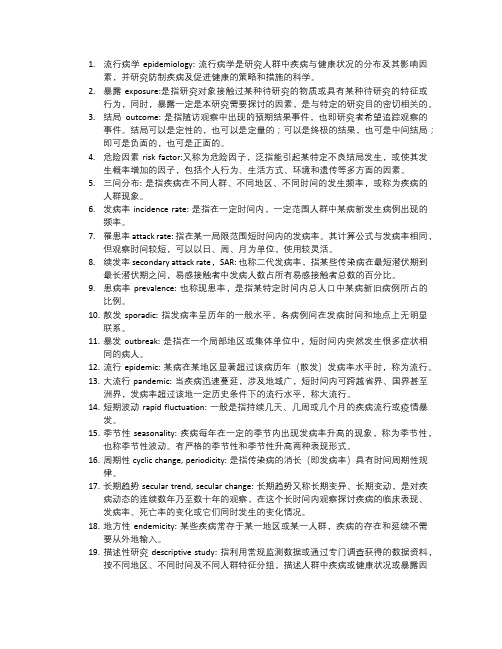
1.流行病学epidemiology: 流行病学是研究人群中疾病与健康状况的分布及其影响因素,并研究防制疾病及促进健康的策略和措施的科学。
2.暴露exposure:是指研究对象接触过某种待研究的物质或具有某种待研究的特征或行为,同时,暴露一定是本研究需要探讨的因素,是与特定的研究目的密切相关的。
3.结局outcome: 是指随访观察中出现的预期结果事件,也即研究者希望追踪观察的事件。
结局可以是定性的,也可以是定量的;可以是终极的结果,也可是中间结局;即可是负面的,也可是正面的。
4.危险因素risk factor:又称为危险因子,泛指能引起某特定不良结局发生,或使其发生概率增加的因子,包括个人行为、生活方式、环境和遗传等多方面的因素。
5.三间分布: 是指疾病在不同人群、不同地区、不同时间的发生频率,或称为疾病的人群现象。
6.发病率incidence rate: 是指在一定时间内,一定范围人群中某病新发生病例出现的频率。
7.罹患率attack rate: 指在某一局限范围短时间内的发病率。
其计算公式与发病率相同,但观察时间较短,可以以日、周、月为单位,使用较灵活。
8.续发率secondary attack rate,SAR: 也称二代发病率,指某些传染病在最短潜伏期到最长潜伏期之间,易感接触者中发病人数占所有易感接触者总数的百分比。
9.患病率prevalence: 也称现患率,是指某特定时间内总人口中某病新旧病例所占的比例。
10.散发sporadic: 指发病率呈历年的一般水平,各病例间在发病时间和地点上无明显联系。
11.暴发outbreak: 是指在一个局部地区或集体单位中,短时间内突然发生很多症状相同的病人。
12.流行epidemic: 某病在某地区显著超过该病历年(散发)发病率水平时,称为流行。
13.大流行pandemic: 当疾病迅速蔓延,涉及地域广,短时间内可跨越省界、国界甚至洲界,发病率超过该地一定历史条件下的流行水平,称大流行。
流行病与卫生统计学常用英语词汇

流行病与卫生统计学常用英语词汇流行病与卫生统计学常用英语词汇常用流行病学用语Accuracy 准确性Age adjustment 年龄调整Age standardization 年龄标化Age-specific rate 年龄别( 发生或死亡) 率Analyt ic epidemiology 分析流行病学Analyt ic study 分析性研究Apgar score 阿氏评分Association 联系, 关联Asymptomatic persons 无症状者, 隐性患者Attack rate 罹患率Attributable risk, AR 归因危险度Attributable risk percent, ARP, AR% 归因危险度百分比Bias 偏倚Biological marker 生物学标记Blinding ( single blinding, double blinding, triple blinding)盲法( 单盲, 双盲, 三盲) Burden of disease, BOD 疾病负担Capture-mark-recapture, CMR 捕获-标记-再捕获Case-control study 病例对照研究Case fatality 病死率Census 普查Clinical trial 临床试验Clinical randomized control trial, CRCT 临床随机对照试验Cluster 聚集Cohort study 队列研究Common-source exposure 同源性暴露Comparability 可比性Confounding 混杂Control group 对照组Cross-sectional study 横断面研究Crude mortality( death) rate 粗死亡率Cumulative incidence 累积发病率Cumulative mortality rate 累积死亡率Death rate 死亡率Dependent variable 应变量Descriptive epidemiology 描述流行病学Descriptive study 描述性研究Disease outbreak 疾病爆发Dose-response relationship 剂量反应关系Eco-epidemiology 生态流行病学Ecologic fallacy 生态学谬误Ecologic study 生态学研究Emergency events 突发事件Endemic disease 地方病Epidemic 流行Etiology 病因学Evidence-based medicine 循征医学Excess risk 超额危险度Exclusions 排除Experimental epidemiology 实验流行病学Exposure 暴露External validity 外部真实性False negative 假阴性False positive 假阳性Familial aggregat ion 家族聚集性Fatality rate 病死率Filed trials 现场试验Follow-up 随访Fixed effects model 固定效应模型Food-borne disease 经食物传播的疾病Genetic epidemiology 遗传流行病学Genetic map 遗传图Genome 基因组Genotype 基因型, 遗传型Global disease burden, GDB 全球疾病负担Gold st andard 金标准Heterogeneity 异质性Historical cohort study 历史队列研究Historical controls 历史对照Homogeneity 同质性Host 宿主Incidence density 发病密度Incidence rate 发病率Incubation period 潜伏期Independent variable 自变量Infection rate 感染率Informat ion bias 信息偏倚Internal validity 内部真实性International Classificat ion of Diseases, ICD 国际疾病分类Latent period 潜伏期Lead-time bias 领先时间偏倚Likelihood ratio 似然比Likelihood ratio for a negative test result 阴性似然比Likelihood ratio for a positive test result 阳性似然比Marker 标记Matching 匹配, 配比Median survival time 平均存活时间Meta-analysis Meta 分析Morbidity 发病率Mortality rate 死亡率Natural history 自然史Negative predictive value 阴性预测值Nosocomial infection 医院内感染Notifiable disease 法定传染病Observat ion bias 观察性偏倚Observat ional study 观察性研究Odds ratio, OR 比值比Opportunistic infection 机会感染Outbreak 爆发Outcome 结果, 结局Outcome variable 结果变量Ove-rmatching 匹配过度Pandemic 大流行Person-time 人时Person-to-person spread 人间传播Person-years 人年Pilot study 预调查, 预试验Population at risk 危险人群Population-based study 人群( 为基础的) 研究Posit ive predictive value 阳性预测值Power 效能Precision 精确度, 精密度Prevalence rate 患病率Proband 先证者Prognosis 预后Prognostic factor 预后因子Proportion 比例Prospective cohort study 前瞻性队列研究Protection rate 保护率Publication bias 发表偏倚Quarantine 检疫Quas-i experiment 半实验, 类实验Random effects model 随机效应模型Randomization 随机化Randomized control ( clinical) trial, RCT 随机对照( 临床) 试验Receiver operator characteristic ( ROC) curve 受试者工作特征曲线Relative risk, RR 相对危险度Reliability 可靠性Response variable 反应变量Retrospective cohort study 回顾性队列研究Risk factor 危险因素, 危险因子Screening 筛检Seasonal variation 季节性, 季节变异Secondary attack rate 续发率Selection bias 选择性偏倚Sem-i experiment 半实验, 类实验Sensitivit y 灵敏度Sent inel case 前哨病例Specificity 特异度Sporadic 散发Surveillance 监测Survival rate 生存率T ransmission 传播, 传染T rue negative 真阴性T rue positive 真阳性Validity 真实性, 效度Variability 变异性, 差异性Youden. s index 约登指数卫生统计学常用词汇Analysis of correlation 相关分析Analysis of regression 回归分析ANOVA ( analysis of variance) 方差分析Arithmetic mean 算术平均数Average 平均数Bar chart 条形图Bar graph 条形图Binary logistic regression 二元逻辑斯蒂回归Binomial distribution 二项分布Categorical variable 分类变量Central tendency 集中趋势Ch-i square test 卡方检验/ V 2检验Circle chart 圆图Cluster sampling 整群抽样Coefficient of regression 回归系数Coefficient of variation 变异系数Completely randomized design 完全随机化设计Confidence interval 置信区间Counts 计数/ 频数Cross-over design 交叉设计Degree of freedom 自由度Design 设计Effect 实验效应Error type Ñ 第一类错误Error type Ò 第二类错误Event 事件Four fold table 四格表General census 全面普查Histogram 直方图Homogeneity of variance 方差齐性Homogeneity test 齐性检验Independence 独立性Independent variable 自变量Individual 个体Intercept 截距Life expectance 预期期望寿命Life table 寿命表line graph 线图Linear correlat ion 直线相关Linear regression 直线回归LSD 最小显著差法的简称Main effect 主效应Mean 均数Median 中位数Median effective dose 半数效量Missing data 缺失值Newman-Keuls method q 检验Nonparametric test 非参数检验Normal distribut ion 正态分布Normal value 正常值Observed value 观察值Ordered categories 有序分类Ordinal variable 有序变量Paired design 配对设计Parameter 参数Parametric test 参数检验Percentage 百分比Pie graph 饼图Population 总体Posit ive correlation 正相关Power of a test 检验效能Guangxi Medical Journal , Feb1 2006 , Vol128 , No12Proport ion 比/ 构成比Standard normal distribution 标准正态分布Quart ile 四分位数Statistic 统计量Random blocks design 随机区组设计Statistical graph 统计图Random event 随机事件Statistical table 统计表Randomization 随机化Stepwise regression 逐步回归Range 极差/ 全距Survey 调查Rank correlation 等级相关Survival 生存分析Rank sum test 秩和检验Survival rate 生存率Ratio 比例Systematic sampling 系统抽样Relative number 相对数Tendency of dispersion 离散趋势Reliability 可靠性Testing of hypotheses 假设检验RXC table RXC 表Two-tailed test 双侧检验Sample 样本Type I error 一类错误/A错误Sample size 样本量Type II error 二类错误/ B错误SAS( Statistical analysis system ) SAS 统计软件包Validity 有效性Significance test 显著性检验Variabilit y 变异性Simple cluster sampling 简单整群抽样Variable 变量SPSS( Statistical package for the social science) SPSS 统计软件Variance 方差Standard deviat ion 标准差Variat ion 变异Standard error 标准误Zero correlation 零相关Probabilit y 概率。
流行病学专业英语词汇
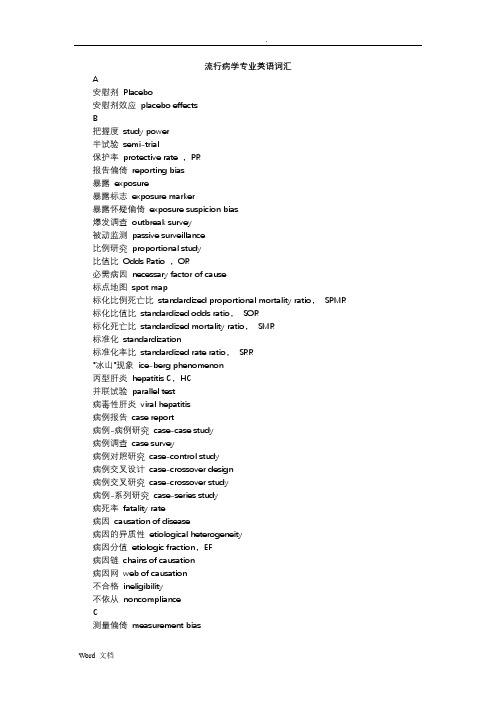
流行病学专业英语词汇A安慰剂Placebo安慰剂效应placebo effectsB把握度study power半试验semi-trial保护率protective rate ,PR报告偏倚reporting bias暴露exposure暴露标志exposure marker暴露怀疑偏倚exposure suspicion bias爆发调查outbreak survey被动监测passive surveillance比例研究proportional study比值比Odds Ratio ,OR必需病因necessary factor of cause标点地图spot map标化比例死亡比standardized proportional mortality ratio,SPMR 标化比值比standardized odds ratio,SOR标化死亡比standardized mortality ratio,SMR标准化standardization标准化率比standardized rate ratio,SRR"冰山"现象ice-berg phenomenon丙型肝炎hepatitis C,HC并联试验parallel test病毒性肝炎viral hepatitis病例报告case report病例-病例研究case-case study病例调查case survey病例对照研究case-control study病例交叉设计case-crossover design病例交叉研究case-crossover study病例-系列研究case-series study病死率fatality rate病因causation of disease病因的异质性etiological heterogeneity病因分值etiologic fraction,EF病因链chains of causation病因网web of causation不合格ineligibility不依从noncomplianceC测量偏倚measurement bias长期变异secular change,trend variation超额死亡率excess mortality超额危险度excess risk巢式病例对照研究nested case-control study成本效果分析cost -effectiveness analysis成本效益分析cost-benefit analysis成本效用分析cost-utility成组匹配category matching抽样调查sampling survey抽样框架sampling frame抽样误差sampling error出生队列birth cohort出生队列分析法birth cohort analysis初级卫生保健primary health care ,PHC传播概率transmission probability传播机制mechanism of transmission传播途径path of transmission传播途径transmission route传播因素transmitting factor传染病communicable diseases传染过程infectious process传染性infectiousness串联试验serial test粗死亡率crude death rate改成crude mortality rate 较好粗一致性crude agreement促成病因contributory factor of cause错分偏倚misclassification bias错误分类misclassificationD大骨节病Kashin-Beck disease大流行pandemic代表性representativeness单倍型haplotype单纯随机抽样simple random sampling单盲single blind单项筛检single screening等位基因allele等位基因频率gene frequency地病endemic diseases地病学Endemiology地性endemicity地性氟中毒endemic fluorosis地性砷中毒endemic arsenism点突变point mutation点源流行point source epidemic碘缺乏病iodine deficiency disease调查随访研究survey follow-up study调整一致性adjusted agreement丁型肝炎hepatitis D,HD动态人群dynamic population毒力virulence短期波动irregular variation,rapid fluctuation队列cohort队列研究cohort study对象报告偏倚report bias多归因程序的法Multiple imputation procedure多国心血管病趋势和决定因素监测Multinational Monitoring of Trends and Determinants inardiovascular Diseases,MONICA多级抽样multistage sampling多群组比较研究multi-group comparison study多态性polymorphism多项筛检multiple screeningE恶性肿瘤流行病学cancer Epidemiology二代侵袭率,续发率secondary attack rate,SAR二级预防secondary preventionF发病率incidence rate,morbidity发病密度incidence density发病密度incidence density发生率研究incidence study飞沫droplet飞沫核droplet nuclei非即时性non-concurrent非均衡性错分differential misclassification非连续性状Discrete traits肺炎与流感死亡率pneumonia and influenza deaths,即P&I deaths分层stratification分层抽样stratified sampling分层随机分组stratified randomization分类变量categorical variable分离分析segregation analysis分子流行病学Molecular Epidemiology封闭性抗体blocking antibodies氟斑牙dental fluorosis氟骨症skeletal fluorosis负混杂negative confounding复等位基因位点multiple alles复杂性状complex traitG概念框架conceptual framework干预随访研究intervention follow-up study感染储主reservoir of infection感染来源source of infection感染力infectivity感染谱spectrum of infection感染梯度gradient of infection感染性腹泻infectious diarrhea感染性腹泻病infectious diarrheal disease感染症infections or infectious diseases高危人群策略high risk strategy个案case个案调查case study个案调查individual survey个体匹配individual matching工程干预engineering intervention共变法method of concomitant variation共显性codominance构成比proportion固定队列fixed cohort故意伤害intentional injuries关联的合理性plausibility of association关联的可重复性consistency of association关联的强度strength of association关联的时间性temporality of association关联的特异性specificity of association关联的一致性coherence of association观察偏倚observational bias观察性研究observational study观察一致率observation agreement广义遗传度broad heritability归因危险度attributable risk归因危险度百分比attributable risk percent,ARP,或AR%国际病毒分类委员会International Committee on Taxonomy of Viruses,ICTV 国际冠心病预防工作组The International Task Force for Prevention of Coronary Heart Disease国际疾病分类第十版International Classification of Diseases,ICD-10结核病防治项目National Tuberculosis Program,NTP卫生统计中心the National Center for Health Statistics,NCHSH合作率cooperation rate核心家系Nuclear families横断面研究cross sectional analysis横断面研究cross-sectional study患病率prevalence rate回顾性研究retrospective studies回忆偏倚recall bias混合型流行mixed epidemic混合研究mixed study混杂confounding混杂偏倚confounding bias混杂因素confounder,confounding factor活跃病区active endemic area获得性免疫缺陷综合症acquired immunodeficiency syndrome,AIDS 霍桑效应Howthorne effectJ机遇chance基本繁殖率basic reproduction rate基本繁殖数basic reproductive number,R0基本人群base population or population at risk基线信息baseline information基因gene基因毒性genotoxic基因型Genotyping基因型频率genotype frequency及时性timeliness疾病爆发disease outbreak疾病标志Markers of disease疾病的分布distribution of disease疾病的自然史natural history of disease疾病监测surveillance of disease疾病链the disease chain剂量反应关系dose-response relationship季节性seasonal variation,seasonality继发关联secondary association家庭簇研究family cluster study家庭聚集性Familial aggregation家庭聚集性研究familial aggregation study家庭相似性Family resemblance家系研究pedigree study甲型肝炎hepatitis A,HA假阳性率false positive rate假阴性率false negative rate间接传播indirect transmission间接关联indirect association间接接触indirect contact检出症侯偏倚detection signal bias简单随机分组simple randomization简明损伤定级法abbreviated injury scale,AIS健康促进health promotion健康工作者效应healthy worker effect健康监测系统health information system,HIS健康生命损失年years of life lived with disability,YLLD 教育干预educational intervention结局outcome结局变量outcome variable截断点cutoff金标准gold standard经济干预economic intervention经节肢动物媒介vector-borne经空气air-borne经食物food-borne经饮水drinking water-borne经载体vehicle-borne精确性precision聚合酶链式反应polymerase chain reaction,PCR均衡性错分non-differential misclassification均数回归趋势regression to the meanK抗原漂移antigenic drift抗原转变antigenic shift克山病Keshan disease空间、时间集研究space-time cluster study扩大免疫计划expanded program on immunization,EPI L来源同一identity by descent,IBD类试验,准试验quasi-trial,quasi-experiment类推法method of analogy累积发病率cumulative incidence罹患率attack rate礼貌偏倚politeness bias理论流行病学theoretical epidemiology历史性historical连锁linkage连锁不平衡linkage disequilibrium连锁分析Linkage analysis连锁平衡linkage equilibrium联合无应答偏倚combined nonrespondent bias联系率contact rate临床试验clinical trial灵敏度sensitivity领先时间偏倚lead time bias流感病毒influenza virus流行epidemic流行病模型epidemic model流行病学epidemiology流行病学监测epidemiological surveillance流行病学实验epidemiological experiment流行过程epidemic process流行曲线epidemic curve流行性出血热epidemic hemorrhagic fever,EHF流行性感冒Influenza流行性肾病nephropathia epidemica,NE率rate率比rate ratio率差rate difference,RD轮状模式wheel modeM蔓延流行propagated or progressive epidemic盲法blindness美国胆固醇教育规划National Cholesterol Education Program,NCEP 描述流行病学descriptive epidemiology描述性研究descriptive study目标人群target populationN暴露剂量Internal Dose部有效性internal validity剂量internal dose剂量的测定internal dose meters纳入/排除偏倚inclusion/exclusion bias奈曼偏倚Neyman biasP排除exclusions排除法method of exclusion排除偏倚exclusive bias配对pair matching"皮鞋"流行病学shoeleather epidemiology匹配matching匹配变量matching variable匹配过头overmatching匹配因素matching factors偏倚bias频数匹配frequency matching普查censusQ前瞻性prospective 8前瞻性研究prospective study潜伏期incubation period潜隐期latent period潜在工作损失年数Working Years of Potential Life Lost,WYPLL潜在价值损失年数Valued Years of Potential Life Lost,VYPLL潜在寿命损失年potential years of life lost,PYLL强制干预enforcement intervention求同法method of agreement求异法method of difference全人群策略population strategy缺课天数days lost from school缺勤天数days lost from work缺失数据missing data确定性检验explicit testing确定性模型deterministic modelR人传人person to person spread人类传染病anthroponosis人类基因组计划human genome project人类免疫缺陷病毒human immunodeficiency virus,HIV人群population人群病因分值population etiologic fraction,PEF人群的分层population stratification人群归因危险度population attributable risk,PAR人群归因危险度百分比population attributable risk percent,PARP 或PAR% 人群免疫性herd immunity人群易感性herd susceptibility人兽共患病,动物传染病zoonosis人畜共患病anthropozoonosis日期型date type入院率偏倚(伯克森偏倚)admission rate bias (Berkson's bias)。
流行病名词解释
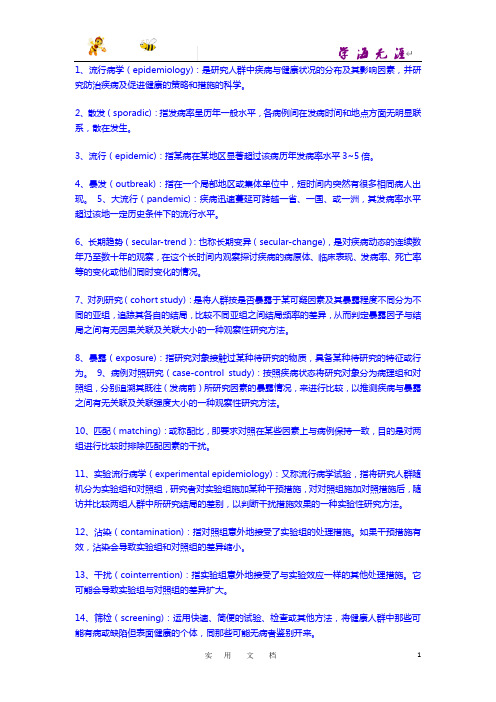
1、流行病学(epidemiology):是研究人群中疾病与健康状况的分布及其影响因素,并研究防治疾病及促进健康的策略和措施的科学。
2、散发(sporadic):指发病率呈历年一般水平,各病例间在发病时间和地点方面无明显联系,散在发生。
3、流行(epidemic):指某病在某地区显著超过该病历年发病率水平3~5倍。
4、暴发(outbreak):指在一个局部地区或集体单位中,短时间内突然有很多相同病人出现。
5、大流行(pandemic):疾病迅速蔓延可跨越一省、一国、或一洲,其发病率水平超过该地一定历史条件下的流行水平。
6、长期趋势(secular-trend):也称长期变异(secular-change),是对疾病动态的连续数年乃至数十年的观察,在这个长时间内观察探讨疾病的病原体、临床表现、发病率、死亡率等的变化或他们同时变化的情况。
7、对列研究(cohort study):是将人群按是否暴露于某可疑因素及其暴露程度不同分为不同的亚组,追踪其各自的结局,比较不同亚组之间结局频率的差异,从而判定暴露因子与结局之间有无因果关联及关联大小的一种观察性研究方法。
8、暴露(exposure):指研究对象接触过某种待研究的物质,具备某种待研究的特征或行为。
9、病例对照研究(case-control study):按照疾病状态将研究对象分为病理组和对照组,分别追溯其既往(发病前)所研究因素的暴露情况,来进行比较,以推测疾病与暴露之间有无关联及关联强度大小的一种观察性研究方法。
10、匹配(matching):或称配比,即要求对照在某些因素上与病例保持一致,目的是对两组进行比较时排除匹配因素的干扰。
11、实验流行病学(experimental epidemiology):又称流行病学试验,指将研究人群随机分为实验组和对照组,研究者对实验组施加某种干预措施,对对照组施加对照措施后,随访并比较两组人群中所研究结局的差别,以判断干扰措施效果的一种实验性研究方法。
流行病学名词解释全

流行病学名词解释全(总8页)本页仅作为文档页封面,使用时可以删除This document is for reference only-rar21year.March流行病学1.流行病学:epidemiology:是研究疾病及健康状况的分布及其影响因素,并研究如何防治疾病及促进健康的策略与措施的科学。
既是一门方法学又是一门应用学科。
2.发病率incidence rate:是一定时期内,特定人群中某病新发病例的频率。
3.罹患率attack rate: 是指在某一局限范围内,短时间内的发病率,观察时间可以日、周、旬或月为单位,适用于局部地区疾病的爆发,或事物中毒、传染病及职业性中毒等爆发情况。
是发病率的特例。
4.患病率prevalence rate:指某特定时间内,可能发生某病的一定人群中某病现患病例(新旧病例)的频率。
分为时点患病率与期间患病率5.死亡率mortality rate:指某人群在一定期间内总死亡人数与该人群同期平均人口数之比。
6.病死率Fatality rate:指一定时间内,患某病的病人中因该病而死亡者的比例7.生存率survival rate:指接受某种治疗的病人或患有某病的人中,经若干年随访后,尚存活病人所占的比例。
8.散发Sporadic:指某病发病人数不多,病例间无明显的相互传播关系,或在一定地区的发病率呈历年一般水平。
9.爆发outbreak:在一个局部地区或集体单位中短时间内出现很多相同的病人10.流行epidemic: 指某地区发病率显著超过历年的散发发病率水平11.大流行Pandemic:指某病的发病蔓延迅速,涉及地域广,人口比例大,在短时间内可以跨过省界国界甚至洲界,形成世界性流行12.季节性seasonality/seasonal variation:疾病的发生率随季节而变化的现象称为季节性13.周期性periodicity:疾病在一定的时间间隔后有规律地发生流行,称为周期性。
流行病学名词解释简答重点
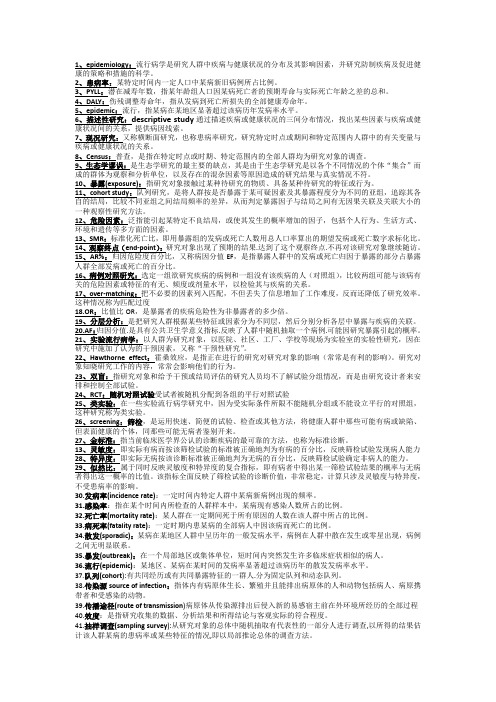
1、epidemiology:流行病学是研究人群中疾病与健康状况的分布及其影响因素,并研究防制疾病及促进健康的策略和措施的科学。
2、患病率:某特定时间内一定人口中某病新旧病例所占比例。
3、PYLL:潜在减寿年数,指某年龄组人口因某病死亡者的预期寿命与实际死亡年龄之差的总和。
4、DALY:伤残调整寿命年,指从发病到死亡所损失的全部健康寿命年。
5、epidemic:流行,指某病在某地区显著超过该病历年发病率水平。
6、描述性研究:descriptive study通过描述疾病或健康状况的三间分布情况,找出某些因素与疾病或健康状况间的关系,提供病因线索。
7、现况研究:又称横断面研究,也称患病率研究,研究特定时点或期间和特定范围内人群中的有关变量与疾病或健康状况的关系。
8、Census:普查,是指在特定时点或时期、特定范围内的全部人群均为研究对象的调查。
9、生态学谬误:是生态学研究的最主要的缺点,其是由于生态学研究是以各个不同情况的个体“集合”而成的群体为观察和分析单位,以及存在的混杂因素等原因造成的研究结果与真实情况不符。
10、暴露(exposure):指研究对象接触过某种待研究的物质、具备某种待研究的特征或行为。
11、cohort study:队列研究,是将人群按是否暴露于某可疑因素及其暴露程度分为不同的亚组,追踪其各自的结局,比较不同亚组之间结局频率的差异,从而判定暴露因子与结局之间有无因果关联及关联大小的一种观察性研究方法。
12、危险因素:泛指能引起某特定不良结局,或使其发生的概率增加的因子,包括个人行为、生活方式、环境和遗传等多方面的因素。
13、SMR:标准化死亡比,即用暴露组的发病或死亡人数用总人口率算出的期望发病或死亡数字求标化比。
14、观察终点(end-point):研究对象出现了预期的结果.达到了这个观察终点.不再对该研究对象继续随访。
15、AR%:归因危险度百分比,又称病因分值EF,是指暴露人群中的发病或死亡归因于暴露的部分占暴露人群全部发病或死亡的百分比。
流行病与卫生统计学常用英语词汇
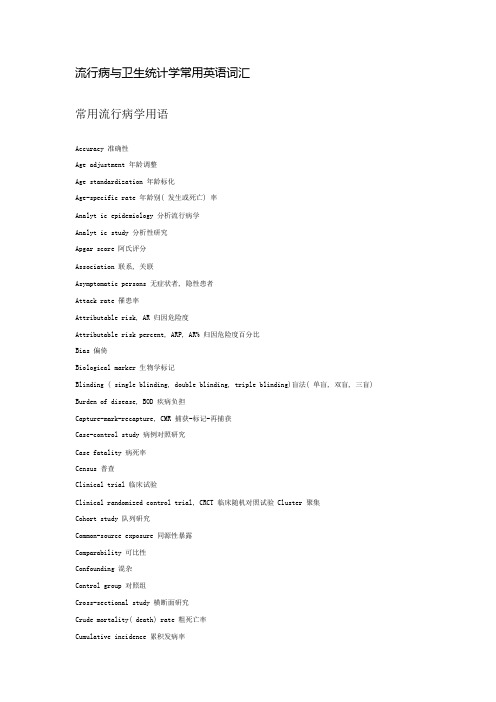
流行病与卫生统计学常用英语词汇常用流行病学用语Accuracy 准确性Age adjustment 年龄调整Age standardization 年龄标化Age-specific rate 年龄别( 发生或死亡) 率Analyt ic epidemiology 分析流行病学Analyt ic study 分析性研究Apgar score 阿氏评分Association 联系, 关联Asymptomatic persons 无症状者, 隐性患者Attack rate 罹患率Attributable risk, AR 归因危险度Attributable risk percent, ARP, AR% 归因危险度百分比Bias 偏倚Biological marker 生物学标记Blinding ( single blinding, double blinding, triple blinding)盲法( 单盲, 双盲, 三盲) Burden of disease, BOD 疾病负担Capture-mark-recapture, CMR 捕获-标记-再捕获Case-control study 病例对照研究Case fatality 病死率Census 普查Clinical trial 临床试验Clinical randomized control trial, CRCT 临床随机对照试验 Cluster 聚集Cohort study 队列研究Common-source exposure 同源性暴露Comparability 可比性Confounding 混杂Control group 对照组Cross-sectional study 横断面研究Crude mortality( death) rate 粗死亡率Cumulative incidence 累积发病率Cumulative mortality rate 累积死亡率Death rate 死亡率Dependent variable 应变量Descriptive epidemiology 描述流行病学Descriptive study 描述性研究Disease outbreak 疾病爆发Dose-response relationship 剂量反应关系Eco-epidemiology 生态流行病学Ecologic fallacy 生态学谬误Ecologic study 生态学研究Emergency events 突发事件Endemic disease 地方病Epidemic 流行Etiology 病因学Evidence-based medicine 循征医学Excess risk 超额危险度Exclusions 排除Experimental epidemiology 实验流行病学Exposure 暴露External validity 外部真实性False negative 假阴性False positive 假阳性Familial aggregat ion 家族聚集性Fatality rate 病死率Filed trials 现场试验Follow-up 随访Fixed effects model 固定效应模型Food-borne disease 经食物传播的疾病Genetic epidemiology 遗传流行病学Genetic map 遗传图Genome 基因组Genotype 基因型, 遗传型Global disease burden, GDB 全球疾病负担Gold st andard 金标准Heterogeneity 异质性Historical cohort study 历史队列研究Historical controls 历史对照Homogeneity 同质性Host 宿主Incidence density 发病密度Incidence rate 发病率Incubation period 潜伏期Independent variable 自变量Infection rate 感染率Informat ion bias 信息偏倚Internal validity 内部真实性International Classificat ion of Diseases, ICD 国际疾病分类Latent period 潜伏期Lead-time bias 领先时间偏倚Likelihood ratio 似然比Likelihood ratio for a negative test result 阴性似然比Likelihood ratio for a positive test result 阳性似然比Marker 标记Matching 匹配, 配比Median survival time 平均存活时间Meta-analysis Meta 分析Morbidity 发病率Mortality rate 死亡率Natural history 自然史Negative predictive value 阴性预测值Nosocomial infection 医院内感染Notifiable disease 法定传染病Observat ion bias 观察性偏倚Observat ional study 观察性研究Odds ratio, OR 比值比Opportunistic infection 机会感染Outbreak 爆发Outcome 结果, 结局Outcome variable 结果变量Ove-rmatching 匹配过度Pandemic 大流行Person-time 人时Person-to-person spread 人间传播Person-years 人年Pilot study 预调查, 预试验Population at risk 危险人群Population-based study 人群( 为基础的) 研究Posit ive predictive value 阳性预测值Power 效能Precision 精确度, 精密度Prevalence rate 患病率Proband 先证者Prognosis 预后Prognostic factor 预后因子Proportion 比例Prospective cohort study 前瞻性队列研究Protection rate 保护率Publication bias 发表偏倚Quarantine 检疫Quas-i experiment 半实验, 类实验Random effects model 随机效应模型Randomization 随机化Randomized control ( clinical) trial, RCT 随机对照( 临床) 试验Receiver operator characteristic ( ROC) curve 受试者工作特征曲线Relative risk, RR 相对危险度Reliability 可靠性Response variable 反应变量Retrospective cohort study 回顾性队列研究Risk factor 危险因素, 危险因子Screening 筛检Seasonal variation 季节性, 季节变异Secondary attack rate 续发率Selection bias 选择性偏倚Sem-i experiment 半实验, 类实验Sensitivit y 灵敏度Sent inel case 前哨病例Specificity 特异度Sporadic 散发Surveillance 监测Survival rate 生存率T ransmission 传播, 传染T rue negative 真阴性T rue positive 真阳性Validity 真实性, 效度Variability 变异性, 差异性 Youden. s index 约登指数卫生统计学常用词汇Analysis of correlation 相关分析Analysis of regression 回归分析ANOVA ( analysis of variance) 方差分析Arithmetic mean 算术平均数Average 平均数Bar chart 条形图Bar graph 条形图Binary logistic regression 二元逻辑斯蒂回归Binomial distribution 二项分布Categorical variable 分类变量Central tendency 集中趋势Ch-i square test 卡方检验/ V 2检验Circle chart 圆图Cluster sampling 整群抽样Coefficient of regression 回归系数Coefficient of variation 变异系数Completely randomized design 完全随机化设计Confidence interval 置信区间Counts 计数/ 频数Cross-over design 交叉设计Degree of freedom 自由度Design 设计。
流行病

循证医学(evidence-based medicine,EBM)P4:指对个体病人的医疗决策的制定不能单纯依靠经验和直觉,而要建立在最佳科学研究证据的基础之上。
流行病学(epidemiology):是研究人群中疾病与健康状况的分布及其影响因素,并研究防制疾病及促进健康的策略和措施的科学。
暴发(outbreak):指在一个局部地区或集中单位中,短时间内突然有很多相同的病例出现。
暴发时病人多有相同的传染源或者传播途径,大多数病人出现在最长潜伏期内。
散发(sporadic):发病率呈历年一般水平,各病例间的发病时间和地点方面无明显联系。
流行(epidemic):某病在某地区的发病情况显著超过该病历年散发发病率水平。
大流行(pandemic):有时疾病迅速蔓延,短时间内可跨越一省、一国或一洲,其发病率水平超过该地一定历史条件下的流行水平。
如鼠疫、流感、霍乱的世界大流行。
长期趋势(secular trend):又称长期变异,是指在一个相当长的时间内(多为几年或几十年),观察探讨疾病的临床表现、发病率、死亡率的变化或它们同时发生的变化情况。
队列(cohort)指具有共同特征或者共同经历的一群人。
匹配(matching):或称配比,即要求对照在某些因素或特征上与病例保持一致,目的是对两组进行比较时排除匹配因素的干扰。
传播途径(route of transmission)指病原体从传染源排出后,侵入新的易感宿主前,在外环境中所经历的全部过程。
病因:能使疾病发生率升高的因素,包括化学、物理、生物精神心理以及遗传等。
传播机制(mechanism of transmission)病原体从一个宿主转移到另一个宿主的过程,即病原体更换宿主的过程,包括病原体排出途径、传播途径和侵入途径。
暴露(exposure)是流行病学的一个术语。
它是指研究对象接触于某些因素或具备某些特征或处于某种状态,这些因素、特征、状态即为暴露因素。
(完整版)流行病学专业英语词汇
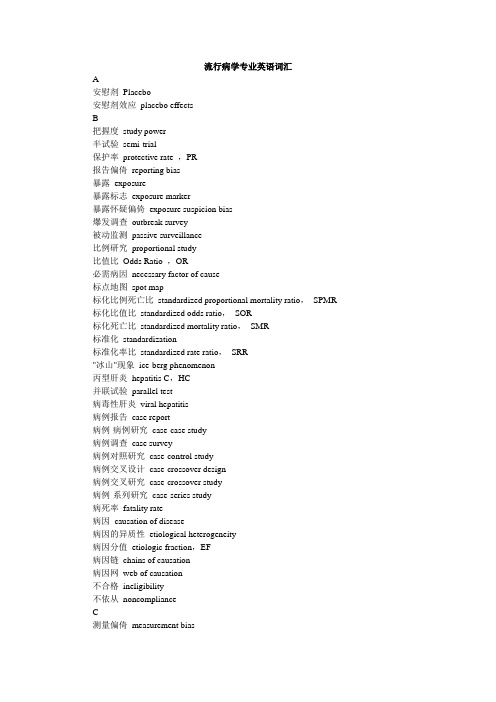
流行病学专业英语词汇A安慰剂Placebo安慰剂效应placebo effectsB把握度study power半试验semi-trial保护率protective rate ,PR报告偏倚reporting bias暴露exposure暴露标志exposure marker暴露怀疑偏倚exposure suspicion bias爆发调查outbreak survey被动监测passive surveillance比例研究proportional study比值比Odds Ratio ,OR必需病因necessary factor of cause标点地图spot map标化比例死亡比standardized proportional mortality ratio,SPMR 标化比值比standardized odds ratio,SOR标化死亡比standardized mortality ratio,SMR标准化standardization标准化率比standardized rate ratio,SRR"冰山"现象ice-berg phenomenon丙型肝炎hepatitis C,HC并联试验parallel test病毒性肝炎viral hepatitis病例报告case report病例-病例研究case-case study病例调查case survey病例对照研究case-control study病例交叉设计case-crossover design病例交叉研究case-crossover study病例-系列研究case-series study病死率fatality rate病因causation of disease病因的异质性etiological heterogeneity病因分值etiologic fraction,EF病因链chains of causation病因网web of causation不合格ineligibility不依从noncomplianceC测量偏倚measurement bias长期变异secular change,trend variation超额死亡率excess mortality超额危险度excess risk巢式病例对照研究nested case-control study成本效果分析cost -effectiveness analysis成本效益分析cost-benefit analysis成本效用分析cost-utility成组匹配category matching抽样调查sampling survey抽样框架sampling frame抽样误差sampling error出生队列birth cohort出生队列分析法birth cohort analysis初级卫生保健primary health care ,PHC传播概率transmission probability传播机制mechanism of transmission传播途径path of transmission传播途径transmission route传播因素transmitting factor传染病communicable diseases传染过程infectious process传染性infectiousness串联试验serial test粗死亡率crude death rate改成crude mortality rate 较好粗一致性crude agreement促成病因contributory factor of cause错分偏倚misclassification bias错误分类misclassificationD大骨节病Kashin-Beck disease大流行pandemic代表性representativeness单倍型haplotype单纯随机抽样simple random sampling单盲single blind单项筛检single screening等位基因allele等位基因频率gene frequency地方病endemic diseases地方病学Endemiology地方性endemicity地方性氟中毒endemic fluorosis地方性砷中毒endemic arsenism点突变point mutation点源流行point source epidemic碘缺乏病iodine deficiency disease调查随访研究survey follow-up study调整一致性adjusted agreement丁型肝炎hepatitis D,HD动态人群dynamic population毒力virulence短期波动irregular variation,rapid fluctuation队列cohort队列研究cohort study对象报告偏倚report bias多归因程序的方法Multiple imputation procedure多国心血管病趋势和决定因素监测Multinational Monitoring of Trends and Determinants inardiovascular Diseases,MONICA 多级抽样multistage sampling多群组比较研究multi-group comparison study多态性polymorphism多项筛检multiple screeningE恶性肿瘤流行病学cancer Epidemiology二代侵袭率,续发率secondary attack rate,SAR二级预防secondary preventionF发病率incidence rate,morbidity发病密度incidence density发病密度incidence density发生率研究incidence study飞沫droplet飞沫核droplet nuclei非即时性non-concurrent非均衡性错分differential misclassification非连续性状Discrete traits肺炎与流感死亡率pneumonia and influenza deaths,即P&I deaths分层stratification分层抽样stratified sampling分层随机分组stratified randomization分类变量categorical variable分离分析segregation analysis分子流行病学Molecular Epidemiology封闭性抗体blocking antibodies氟斑牙dental fluorosis氟骨症skeletal fluorosis负混杂negative confounding复等位基因位点multiple alles复杂性状complex traitG概念框架conceptual framework干预随访研究intervention follow-up study感染储主reservoir of infection感染来源source of infection感染力infectivity感染谱spectrum of infection感染梯度gradient of infection感染性腹泻infectious diarrhea感染性腹泻病infectious diarrheal disease感染症infections or infectious diseases高危人群策略high risk strategy个案case个案调查case study个案调查individual survey个体匹配individual matching工程干预engineering intervention共变法method of concomitant variation共显性codominance构成比proportion固定队列fixed cohort故意伤害intentional injuries关联的合理性plausibility of association关联的可重复性consistency of association关联的强度strength of association关联的时间性temporality of association关联的特异性specificity of association关联的一致性coherence of association观察偏倚observational bias观察性研究observational study观察一致率observation agreement广义遗传度broad heritability归因危险度attributable risk归因危险度百分比attributable risk percent,ARP,或AR%国际病毒分类委员会International Committee on Taxonomy of Viruses,ICTV 国际冠心病预防工作组The International Task Force for Prevention of Coronary Heart Disease国际疾病分类第十版International Classification of Diseases,ICD-10国家结核病防治项目National Tuberculosis Program,NTP国家卫生统计中心the National Center for Health Statistics,NCHSH合作率cooperation rate核心家系Nuclear families横断面研究cross sectional analysis横断面研究cross-sectional study患病率prevalence rate回顾性研究retrospective studies回忆偏倚recall bias混合型流行mixed epidemic混合研究mixed study混杂confounding混杂偏倚confounding bias混杂因素confounder,confounding factor活跃病区active endemic area获得性免疫缺陷综合症acquired immunodeficiency syndrome,AIDS 霍桑效应Howthorne effectJ机遇chance基本繁殖率basic reproduction rate基本繁殖数basic reproductive number,R0基本人群base population or population at risk基线信息baseline information基因gene基因毒性genotoxic基因型Genotyping基因型频率genotype frequency及时性timeliness疾病爆发disease outbreak疾病标志Markers of disease疾病的分布distribution of disease疾病的自然史natural history of disease疾病监测surveillance of disease疾病链the disease chain剂量反应关系dose-response relationship季节性seasonal variation,seasonality继发关联secondary association家庭簇研究family cluster study家庭聚集性Familial aggregation家庭聚集性研究familial aggregation study家庭相似性Family resemblance家系研究pedigree study甲型肝炎hepatitis A,HA假阳性率false positive rate假阴性率false negative rate间接传播indirect transmission间接关联indirect association间接接触indirect contact检出症侯偏倚detection signal bias简单随机分组simple randomization简明损伤定级法abbreviated injury scale,AIS健康促进health promotion健康工作者效应healthy worker effect健康监测系统health information system,HIS健康生命损失年years of life lived with disability,YLLD 教育干预educational intervention结局outcome结局变量outcome variable截断点cutoff金标准gold standard经济干预economic intervention经节肢动物媒介vector-borne经空气air-borne经食物food-borne经饮水drinking water-borne经载体vehicle-borne精确性precision聚合酶链式反应polymerase chain reaction,PCR均衡性错分non-differential misclassification均数回归趋势regression to the meanK抗原漂移antigenic drift抗原转变antigenic shift克山病Keshan disease空间、时间集研究space-time cluster study扩大免疫计划expanded program on immunization,EPIL来源同一identity by descent,IBD类试验,准试验quasi-trial,quasi-experiment类推法method of analogy累积发病率cumulative incidence罹患率attack rate礼貌偏倚politeness bias理论流行病学theoretical epidemiology历史性historical连锁linkage连锁不平衡linkage disequilibrium连锁分析Linkage analysis连锁平衡linkage equilibrium联合无应答偏倚combined nonrespondent bias联系率contact rate临床试验clinical trial灵敏度sensitivity领先时间偏倚lead time bias流感病毒influenza virus流行epidemic流行病模型epidemic model流行病学epidemiology流行病学监测epidemiological surveillance流行病学实验epidemiological experiment流行过程epidemic process流行曲线epidemic curve流行性出血热epidemic hemorrhagic fever,EHF流行性感冒Influenza流行性肾病nephropathia epidemica,NE率rate率比rate ratio率差rate difference,RD轮状模式wheel modeM蔓延流行propagated or progressive epidemic盲法blindness美国国家胆固醇教育规划National Cholesterol Education Program,NCEP 描述流行病学descriptive epidemiology描述性研究descriptive study目标人群target populationN内暴露剂量Internal Dose内部有效性internal validity内剂量internal dose内剂量的测定internal dose meters纳入/排除偏倚inclusion/exclusion bias奈曼偏倚Neyman biasP排除exclusions排除法method of exclusion排除偏倚exclusive bias配对pair matching"皮鞋"流行病学shoeleather epidemiology匹配matching匹配变量matching variable匹配过头overmatching匹配因素matching factors偏倚bias频数匹配frequency matching普查censusQ前瞻性prospective 8前瞻性研究prospective study潜伏期incubation period潜隐期latent period潜在工作损失年数Working Years of Potential Life Lost,WYPLL潜在价值损失年数Valued Years of Potential Life Lost,VYPLL潜在寿命损失年potential years of life lost,PYLL强制干预enforcement intervention求同法method of agreement求异法method of difference全人群策略population strategy缺课天数days lost from school缺勤天数days lost from work缺失数据missing data确定性检验explicit testing确定性模型deterministic modelR人传人person to person spread人类传染病anthroponosis人类基因组计划human genome project人类免疫缺陷病毒human immunodeficiency virus,HIV人群population人群病因分值population etiologic fraction,PEF人群的分层population stratification人群归因危险度population attributable risk,PAR人群归因危险度百分比population attributable risk percent,PARP 或PAR% 人群免疫性herd immunity人群易感性herd susceptibility人兽共患病,动物传染病zoonosis人畜共患病anthropozoonosis日期型date type入院率偏倚(伯克森偏倚)admission rate bias (Berkson's bias)。
17.12 流行病学 名解
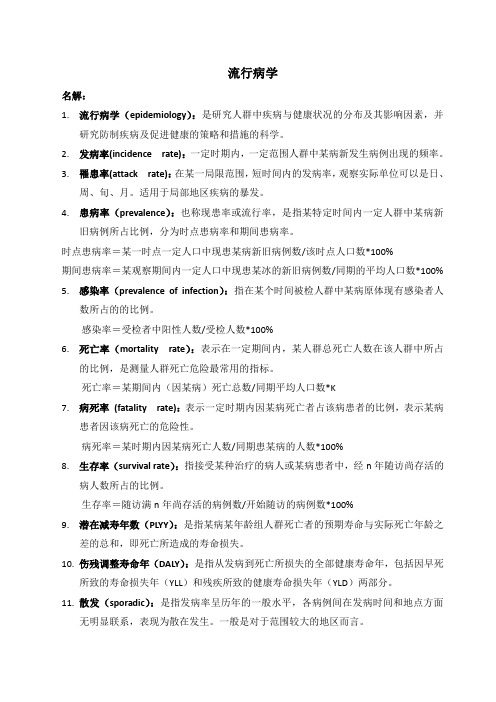
流行病学名解:1.流行病学(epidemiology):是研究人群中疾病与健康状况的分布及其影响因素,并研究防制疾病及促进健康的策略和措施的科学。
2.发病率(incidence rate):一定时期内,一定范围人群中某病新发生病例出现的频率。
3.罹患率(attack rate):在某一局限范围,短时间内的发病率,观察实际单位可以是日、周、旬、月。
适用于局部地区疾病的暴发。
4.患病率(prevalence):也称现患率或流行率,是指某特定时间内一定人群中某病新旧病例所占比例,分为时点患病率和期间患病率。
时点患病率=某一时点一定人口中现患某病新旧病例数/该时点人口数*100%期间患病率=某观察期间内一定人口中现患某冰的新旧病例数/同期的平均人口数*100% 5.感染率(prevalence of infection):指在某个时间被检人群中某病原体现有感染者人数所占的的比例。
感染率=受检者中阳性人数/受检人数*100%6.死亡率(mortality rate):表示在一定期间内,某人群总死亡人数在该人群中所占的比例,是测量人群死亡危险最常用的指标。
死亡率=某期间内(因某病)死亡总数/同期平均人口数*K7.病死率(fatality rate):表示一定时期内因某病死亡者占该病患者的比例,表示某病患者因该病死亡的危险性。
病死率=某时期内因某病死亡人数/同期患某病的人数*100%8.生存率(survival rate):指接受某种治疗的病人或某病患者中,经n年随访尚存活的病人数所占的比例。
生存率=随访满n年尚存活的病例数/开始随访的病例数*100%9.潜在减寿年数(PLYY):是指某病某年龄组人群死亡者的预期寿命与实际死亡年龄之差的总和,即死亡所造成的寿命损失。
10.伤残调整寿命年(DALY):是指从发病到死亡所损失的全部健康寿命年,包括因早死所致的寿命损失年(YLL)和残疾所致的健康寿命损失年(YLD)两部分。
流行病复习资料总结
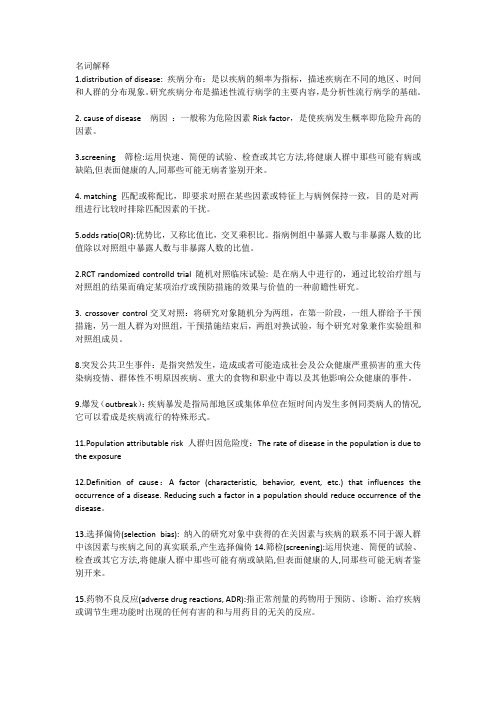
名词解释1.distribution of disease: 疾病分布:是以疾病的频率为指标,描述疾病在不同的地区、时间和人群的分布现象。
研究疾病分布是描述性流行病学的主要内容,是分析性流行病学的基础。
2. cause of disease 病因:一般称为危险因素Risk factor,是使疾病发生概率即危险升高的因素。
3.screening 筛检:运用快速、简便的试验、检查或其它方法,将健康人群中那些可能有病或缺陷,但表面健康的人,同那些可能无病者鉴别开来。
4. matching 匹配或称配比,即要求对照在某些因素或特征上与病例保持一致,目的是对两组进行比较时排除匹配因素的干扰。
5.odds ratio(OR):优势比,又称比值比,交叉乘积比。
指病例组中暴露人数与非暴露人数的比值除以对照组中暴露人数与非暴露人数的比值。
2.RCT randomized controlld trial 随机对照临床试验: 是在病人中进行的,通过比较治疗组与对照组的结果而确定某项治疗或预防措施的效果与价值的一种前瞻性研究。
3. crossover control交叉对照:将研究对象随机分为两组,在第一阶段,一组人群给予干预措施,另一组人群为对照组,干预措施结束后,两组对换试验,每个研究对象兼作实验组和对照组成员。
8.突发公共卫生事件:是指突然发生,造成或者可能造成社会及公众健康严重损害的重大传染病疫情、群体性不明原因疾病、重大的食物和职业中毒以及其他影响公众健康的事件。
9.爆发(outbreak):疾病暴发是指局部地区或集体单位在短时间内发生多例同类病人的情况,它可以看成是疾病流行的特殊形式。
11.Population attributable risk 人群归因危险度:The rate of disease in the population is due to the exposure12.Definition of cause:A factor (characteristic, behavior, event, etc.) that influences the occurrence of a disease. Reducing such a factor in a population should reduce occurrence of the disease。
流行病学英文总结
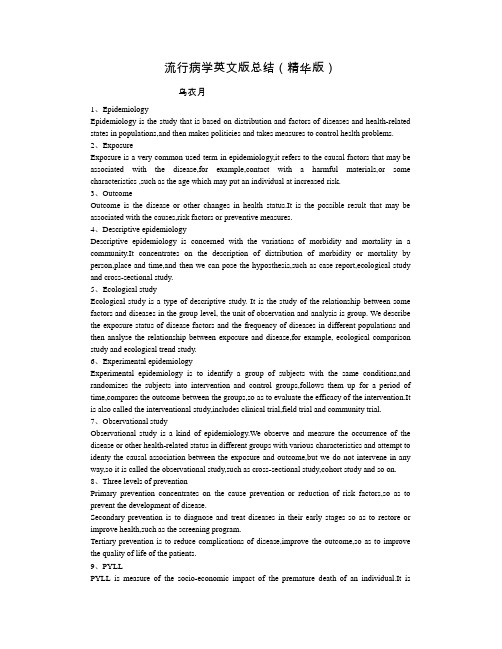
流行病学英文版总结(精华版)乌衣月Email:Frnbdx@1、EpidemiologyEpidemiology is the study that is based on distribution and factors of diseases and health-related states in populations,and then makes politicies and takes measures to control heslth problems.2、ExposureExposure is a very common used term in epidemiology,it refers to the causal factors that may be associated with the disease,for example,contact with a harmful materials,or some characteristics ,such as the age which may put an individual at increased risk.3、OutcomeOutcome is the disease or other changes in health status.It is the possible result that may be associated with the causes,risk factors or preventive measures.4、Descriptive epidemiologyDescriptive epidemiology is concerned with the variations of morbidity and mortality in a community.It concentrates on the description of distribution of morbidity or mortality by person,place and time,and then we can pose the hyposthesis,such as case report,ecological study and cross-sectional study.5、Ecological studyEcological study is a type of descriptive study.It is the study of the relationship between some factors and diseases in the group level, the unit of observation and analysis is group.We describe the exposure status of disease factors and the frequency of diseases in different populations and then analyse the relationship between exposure and disease,for example, ecological comparison study and ecological trend study.6、Experimental epidemiologyExperimental epidemiology is to identify a group of subjects with the same conditions,and randomizes the subjects into intervention and control groups,follows them up for a period of time,compares the outcome between the groups,so as to evaluate the efficacy of the intervention.It is also called the interventional study,includes clinical trial,field trial and community trial.7、Observational studyObservational study is a kind of epidemiology.We observe and measure the occurrence of the disease or other health-related status in different groups with various characteristics and attempt to identy the causal association between the exposure and outcome,but we do not intervene in any way,so it is called the observational study,such as cross-sectional study,cohort study and so on.8、Three levels of preventionPrimary prevention concentrates on the cause prevention or reduction of risk factors,so as to prevent the development of disease.Secondary prevention is to diagnose and treat diseases in their early stages so as to restore or improve health,such as the screening program.Tertiary prevention is to reduce complications of disease,improve the outcome,so as to improve the quality of life of the patients.9、PYLLPYLL is measure of the socio-economic impact of the premature death of an individual.It ismeasured by deducting the age of death from the life expectancy of the individual.10、IncidenceIncidence measures the rate of occurrence of new cases of disease in a given population in a given time and can be used to describe the risk of disease in that population.(number of new cases/population)10、PrevalencePrevalence measures the rate of occurrence of both new and ongoing cases of diseases in a given population,in a given time,and can be used to describe the burden of disease in that population,includes point prevalence and period prevalence.(number of existing cases/population at risk)11、Cross-sectional studyCross-sectional study is a type of descriptive study,is also called prevalence study.It is an investigation that systematically collects information in a given time and does not use intervention.It concentrates on description of the distribution of prevalence rate by person,place,and time,and then we can pose the hyposthesis.12、BiasBias is a systematic error ,it exsits in the design ,conduct or analysis of a study and it may result in a mistaken estimate of the association between the exposure and outcome,such as selection bias,information bias,confounding bias.13、Confounding biasConfounding variable is an extraneous factor that relates(positively or negatively)with both the outcome and the tentative factor of study ,and may result in a mistaken estimate of an exposure effect on the risk of disease.And the bias which is caused by the confounding variable is called confounding bias.14、ScreeningScreening is the early detection and presumptive identification of an unrecognized disease or deficit by application of examinations or tests which can be applied rapidly and cheaply to large populations.15、Cohort studyCohort study is a kind of observational study.The investigator selects a group of exposed individuals and a group(or groups)of non-exposed individuals,and follows up both groups for a period of time,to compare the incidence of disease or the death rate of the disease in the two groups(or more groups)and measure the association between the exposure and the outcome.It is also called a prospective study or follow-up study.16、Case-control studiesCase-control studies start with the identification of people with the disease of interst and a control group of people without this disease ,then collect some information of the exposure in both groups,and measure the association between the exposure and the disease by comparing the diseased and non-diseased group.It is a kind of observational study ,and it is also called the retrospective study.17、MatchingMatching is defined as the process of making a study group and a comparison group comparable with respect to certain characteristics,such as sex,age,race and so on.The puepose of matching is to reduce the likelihood of confounding,includes individual matching and frequency matching.18、OROR is a very useful measure for the association between exposure and outcome.It is the ratio of the odds of exposure among the cases to the odds of exposure among the controls.The more the or departs from one,the greater the association between the exposure and outcome.19、RRRR is the most common measure for the association between esposure and outcome.The meaning is how many times the risk of exposed people is that of unexposed.If RR=1 it means the risk in exposed group and unexposed group are equal ,there is no association between the exposure and the outcome.If RR>1 it means the risk in exposed group is greater than the unexposed group,there is a positive association between the exposure and the outcome.If RR<1 it means the risk in exposed group is less than the unexposed group,there is a negative association between the exposure and the outcome.20、ARAR is a very important and commom measure for the effect of the exposure.It is the difference of the risks between the exposed group an unexposed group.The AR can be interpreted as the risk caused by the exposure only,or the risk attributable to the exposure.21、CauseCause may indicate that the factors that may increase the probability of the disease and that a diminution of one or more of these factors may decrease the frequency of that disease.22.Case Control & Cohort Study DifferencesCase Control Studies Cohort StudyAdvantages They are quicker and inexpensive to conduct It can measure the incidence ofdisease,so it can tmeasure RR They are good for rare diseases It good for rare exposuresThe sample size is smaller than cohort study It is prospective and permitsmultiple outcomes to beassessed in the same studyThey are good for new serious diseases to explore the possible causes The temporal sequence is appropriate,so it good for causal association inferenceDisadvantages They are retrospective,temporal sequence maybe a problem,so it is difficult to establish theassociation between exposure and diseases It requires large sample sizes and need long follow-up periodsThere are some potential biases,such asselection bias,recall biasIt is very expensiveThey can not measure the incidence of disease,therefore can not measure RR It is inefficient for rare diseasesThey are iefficient for rare exposures Some biases:loss to follow-upbias,measurement bias23、Molecular epidemiologyMolecular epidemiology is a branch of epidemiology.It combines theories and methods in both epidemiology and molecular biology.The definition of molecular epidemiology is its use of biological and genetic markers as a measure of the prospensity of developing a disease or as an indicator of a disease or all exposure in the studies of the distribution and causes of disease. Molecular epidemiology has the same objectives as conventional epidemiology,to study the occurrence,development and prognosis of disease,to evaluate the effectiveness of interventions,and to provide evidence for clinical and healthcare decision making in a defined population.References:((1)李立明主编.流行病学.第6版.北京:人民卫生出版社.2007(2)赵仲堂主编.流行病学研究方法与应用.第2版.北京:科学出版社,2005(3)Wang Peishan.Epidemiology An Introduction for Medical Students.Tianjin:Tianjin Science and Technology Translation Publishing Company,2011(4)Rothman KJ. Epidemiology:An Introduction.New York:Oxford University Press,2002 (5)方积乾主编.卫生统计学第6版.北京:人民卫生出版社.2007(6)颜虹主编.医学统计学第2版.北京:人民卫生出版社.2010(流行病学和卫生统计学两部分,以流行病学为主,由于水平有限,时间有限,存在各种问题不可避免,还望指出纠正!)乌衣月2013年4月13日。
流行病学常用中英文对照
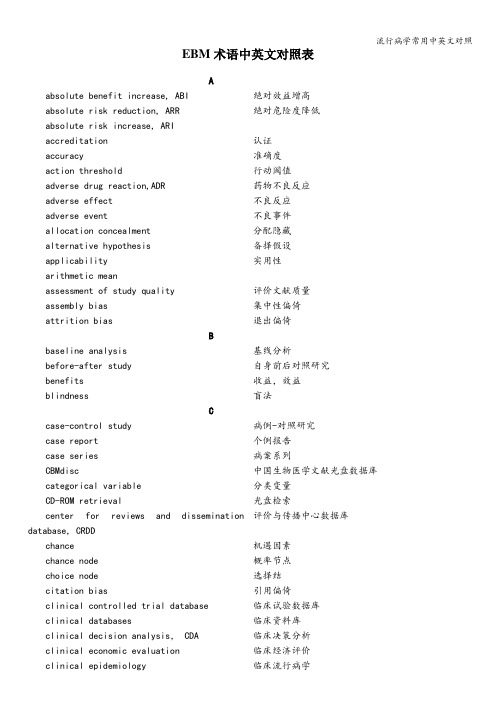
流行病学常用中英文对照EBM术语中英文对照表Aabsolute benefit increase, ABI绝对效益增高absolute risk reduction, ARR绝对危险度降低absolute risk increase, ARIaccreditation认证accuracy准确度action threshold行动阈值adverse drug reaction,ADR药物不良反应adverse effect不良反应adverse event不良事件allocation concealment分配隐藏alternative hypothesis备择假设applicability实用性arithmetic meanassessment of study quality评价文献质量assembly bias集中性偏倚attrition bias退出偏倚Bbaseline analysis基线分析before-after study自身前后对照研究benefits收益,效益blindness盲法Ccase-control study病例-对照研究case report个例报告case series病案系列CBMdisc中国生物医学文献光盘数据库categorical variable分类变量CD-ROM retrieval光盘检索评价与传播中心数据库center for reviews and disseminationdatabase, CRDDchance机遇因素chance node概率节点choice node选择结citation bias引用偏倚clinical controlled trial database临床试验数据库clinical databases临床资料库clinical decision analysis, CDA临床决策分析clinical economic evaluation临床经济评价clinical epidemiology临床流行病学流行病学常用中英文对照clinical evidence, CE临床证据clinical pathway临床途径clinical practice guideline, CPG临床实践指南clinical research methodology临床科研方法学Cochrane collaboration Cochrane协作网Cochrane controlled trials register Cochrane对照试验注册资料库Cochrane Library Cochrane图书馆coefficient of variation变异系数cognitive dissonance认知无共振cognitive resonance认知共振cohort study队列研究co—intervention干扰collaborative review groups, CRG协作评价组completed review全文评价,全面评价compliance bias依从性偏倚complimentary medicine补充医学concealed random allocation隐藏随机分组confidence intervals, CI可信区间confounders混杂因素临床试验报告指南consolidated standards of reporting trial,CONSORTconstruct validity结构效度contamination沾染content validity内容效度continuous quality improvement, CQI持续质量改进continuous medical education, CME继续医学教育control event rate, CER对照组事件发生率cost-benefit analysis, CBA成本-效益分析cost—effectiveness analysis, CEA成本-效果分析cost-identification analysis, CIA成本—确定分析cost—minimization analysis, CMA最小成本分析cost—utility analysis, CUA成本—效用分析criteria—related validity效标效度critical appraisal严格评价c ronbach’s alphaα系数cross-over study design交叉对照研究cumulative meta-analysis累积Meta-分析Ddatabase of abstracts of reviews of干预疗效评价摘要数据库effectiveness, DARE“dec hallenge-rechallenge”study“脱离接触-再接触”研究decision tree决策树流行病学常用中英文对照descriptive statistics统计描述detection bias测量偏倚diagnostic criteria诊断标准diagnostic test诊断试验direct costs直接成本direct medical costs直接医疗成本direct nonmedical costs直接非医疗成本disease-adjusted life years, DALYs伤残调整生命年doer最佳证据提供者EEBM teaching循证医学教学effect size效应量Embase Datebase Embase数据库event rate事件发生率evidence-based clinical practice循证临床实践evidence—based medicine循证医学evidence-based management循证管理evidence-based medicine reviews, EBMR循证医学评价evidence-based medicine web sites循证医学网站excluding criteria排除(剔除)标准experimental event rate, EER试验组事件发生率exploratory trial探索性临床试验exposure暴露Fface validity表面效度fixed effects model固定效应模型follow up随访foreground questions前景问题funnel plot analysis“倒漏斗"图形分析Ggeneration of the allocation sequence随机序列产生generic quality of the instrument普通生命质量量表gold standard金标准grand rounds大查房Hhealth technology assessment,HTA卫生技术评估health—related quality of life, HRQL健康相关生命质量heterogeneity不齐性,异质性historical control trial历史性对照研究hypothesis testing假设检验Iinception cohort study截距性队列研究流行病学常用中英文对照including criteria纳入标准incremental analysis增量分析indirect costs间接成本individual patient data, IPD单个病人的资料inferential statistcs统计推断intangible costs隐性成本intention—to—treat analysis, ITT意愿治疗分析internet retrieval因特网检索intraclass correlation coefficients, ICC组内相关系数JJadad scale量表journal club文献交流俱乐部KKappa value Kappa值Lleading time bias领先时间偏倚length bias病程长短偏倚lifelong education终身教育受益与危害的似然比,利弊比likelihood of being helped versus harmed,LHHlikelihood ratio, LR似然比language bias语言偏倚locating studies检索文献location biases定位偏倚Mmagnitude强度making decision analysis决策分析matching配对mean difference均差measurement bias测量性偏倚median survival中位生存时间Medical Subject Headings, MeSH医学主题词表Medline-Index Medicus Online医学索引在线MeSH Browse医学主题词浏览器Meta—analysis汇总分析migration bias迁移性偏倚mixed effect model混合效应模型model analysis模型分析multiple publication bias多次发表偏倚multivariable analysis多变量分析NN of 1 trials单病例随机试验流行病学常用中英文对照negative likelihood ratio阴性似然比negative predictive value, NPV阴性预测值non—randomized concurrent control trial非随机同期对照研究null hypothesis无效假设number needed to diagnosis, NND需要诊断的人数number needed to harm, NNH需要多少患者接触致病因素才能产生1例额外的不良反应number needed to screen, NNS需要筛检的病人数number needed to treat, NNT预防1例不良事件的发生,需要治疗的总例数Oodds ratio, OR比数比(比值比)opinion—based practice经验医学outcome research结局研究Pparallel test平行试验patient’s expected event rate (PEER)病人预期事件发生率performance bias实施偏倚Permuted Index医学主题词轮排表per protocol, PP按方案分析pooling合并positive likelihood ratio阳性似然比positive predictive value, PPV阳性预测值post—test probability验后概率practice EBM循证医学实践Practice Guideline实践指南precision精确性,精度pre-clinical students临床前期的医学生predictive value预测值pre—test probability/prevalence验前概率/患病率prevalence患病率prognosis预后prognostic factor预后因素proportion构成比protocol研究方案publication bias发表偏倚publication type文献类型Qqualitative systematic review定性系统评价quality adjusted life years,QALYs质量调整生命年quality of life, QOL生命质量Quality of reporting of Meta-analyses Meta—分析质量评价指南流行病学常用中英文对照statement(QUOROM)quality scales and components质量量表与构成quantitative systematic review定量系统评价quartile四分位数间距Rrandom allocation随机分配random effects model随机效应模型randomization随机化randomized control trial, RCT随机对照试验reaction反应性receiver operator characteristic curve ROC曲线relative benefit increase, RBI相对效益增高(率)relative risk/risk ratio, relative risk, RR相对危险度relative risk increase, RRI相对危险增高(率)relative risk reduction, RRR相对危险度减少(率)reliability信度,可靠性reproducible可重复性restriction限制retrospective回顾性review manager: Revman系统评价管理软件risk difference率差/危险差risks风险Sscale量表screening test筛查试验selecting bias选择性偏倚selecting studies选择文献sensitivity敏感性sensitivity analysis敏感性分析sequential trial序贯试验serial test序列试验severe adverse event, SAE严重不良事件significance test显著性检验size of test检验水准specific quality of life instrument专用生命质量量表specificity特异性split—half reliability折半信度standard deviation标准差stratification分层stratify factor分层因素stratify randomization分层随机法subgroup analysis亚组分析流行病学常用中英文对照subheadings副主题词survival curve生存曲线survival rate生存率systematic review系统综述Ttest—retest reliability重测信度test threshold诊断阈值treatment shreshold治疗阈值time frame时间框架total quality management, TQM全面质量管理Uuser最佳证据应用者utility效用Vvalidity效度,真实性Wweighted mean difference, WMD加权均数差“worst-case"scenario“最差情况”演示分析Zzero time零点。
流行病
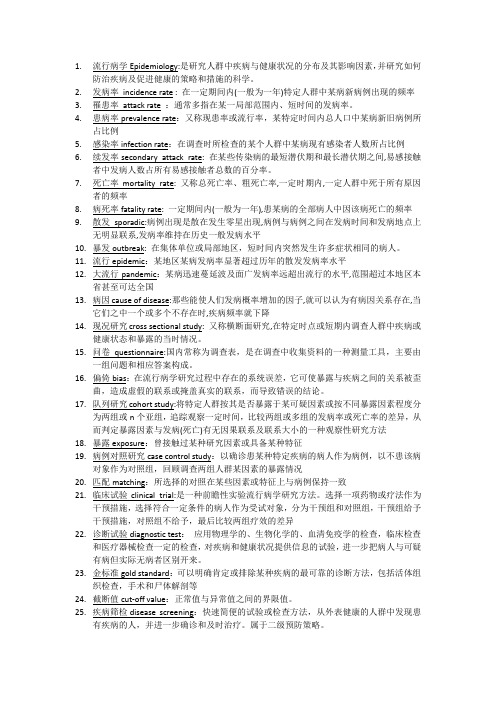
1.流行病学Epidemiology:是研究人群中疾病与健康状况的分布及其影响因素,并研究如何防治疾病及促进健康的策略和措施的科学。
2.发病率incidence rate :在一定期间内(一般为一年)特定人群中某病新病例出现的频率3.罹患率attack rate:通常多指在某一局部范围内、短时间的发病率。
4.患病率prevalence rate:又称现患率或流行率,某特定时间内总人口中某病新旧病例所占比例5.感染率infection rate:在调查时所检查的某个人群中某病现有感染者人数所占比例6.续发率secondary attack rate:在某些传染病的最短潜伏期和最长潜伏期之间,易感接触者中发病人数占所有易感接触者总数的百分率。
7.死亡率mortality rate:又称总死亡率、粗死亡率,一定时期内,一定人群中死于所有原因者的频率8.病死率fatality rate:一定期间内(一般为一年),患某病的全部病人中因该病死亡的频率9.散发sporadic:病例出现是散在发生零星出现,病例与病例之间在发病时间和发病地点上无明显联系,发病率维持在历史一般发病水平10.暴发outbreak:在集体单位或局部地区,短时间内突然发生许多症状相同的病人。
11.流行epidemic:某地区某病发病率显著超过历年的散发发病率水平12.大流行pandemic:某病迅速蔓延波及面广发病率远超出流行的水平,范围超过本地区本省甚至可达全国13.病因cause of disease:那些能使人们发病概率增加的因子,就可以认为有病因关系存在,当它们之中一个或多个不存在时,疾病频率就下降14.现况研究cross sectional study:又称横断面研究,在特定时点或短期内调查人群中疾病或健康状态和暴露的当时情况。
15.问卷questionnaire:国内常称为调查表,是在调查中收集资料的一种测量工具,主要由一组问题和相应答案构成。
甲型流感英语词汇

甲型流感英语词汇
甲型流感的英语词汇:
flu vaccine(流感疫苗)
flu caseload(感染病例数)
flu strain(流感病毒株)
anti-viral medications(抗病毒药物) contagious(会传染的)
respiratory disease(呼吸道疾病) circulate(传播)
contaminate(传染)
infect(感染)
contract(感染)
epidemic(流行病,时疫) epidemiologists(流行病学专家) pandemic(尤指全国性流行的疾病) pneumonias(肺炎)
confirmed case(确诊病例)
suspected case(疑似病例)
incubation period(潜伏期)
outbreak(爆发)
mutate into a more human-to-human
transmission/spread/infection(人与人之间的传播/感染) antiviral drug(抗病毒药物)
quarantee(医学隔离)
step up surveillance(加强检测)
flu jitters(流感恐慌)
contain(遏制)
stem the spread of the virus(制止病毒的扩散)
dangerous strain(突变成更危险病毒株)
public health emergency of international concern(国际关注的突发公共卫生事件)。
- 1、下载文档前请自行甄别文档内容的完整性,平台不提供额外的编辑、内容补充、找答案等附加服务。
- 2、"仅部分预览"的文档,不可在线预览部分如存在完整性等问题,可反馈申请退款(可完整预览的文档不适用该条件!)。
- 3、如文档侵犯您的权益,请联系客服反馈,我们会尽快为您处理(人工客服工作时间:9:00-18:30)。
流行病学专业英语词汇 A 安慰剂Placebo 安慰剂效应placebo effects B 把握度study power 半试验semi-trial 保护率protective rate ,PR 报告偏倚reporting bias 暴露exposure 暴露标志exposure marker 暴露怀疑偏倚exposure suspicion bias 爆发调查outbreak survey 被动监测passive surveillance 比例研究proportional study 比值比Odds Ratio ,OR 必需病因necessary factor of cause 标点地图spot map 标化比例死亡比standardized proportional mortality ratio,SPMR 标化比值比standardized odds ratio,SOR 标化死亡比standardized mortality ratio,SMR 标准化standardization 标准化率比standardized rate ratio,SRR "冰山"现象ice-berg phenomenon 丙型肝炎hepatitis C,HC 并联试验parallel test 病毒性肝炎viral hepatitis 病例报告case report 病例-病例研究case-case study 病例调查case survey 病例对照研究case-control study 病例交叉设计case-crossover design 病例交叉研究case-crossover study 病例-系列研究case-series study 病死率fatality rate 病因causation of disease 病因的异质性etiological heterogeneity 病因分值etiologic fraction,EF 病因链chains of causation 病因网web of causation 不合格ineligibility 不依从noncompliance C 测量偏倚measurement bias 长期变异secular change,trend variation 超额死亡率excess mortality 超额危险度excess risk 巢式病例对照研究nested case-control study 成本效果分析cost -effectiveness analysis 成本效益分析cost-benefit analysis 成本效用分析cost-utility 成组匹配category matching 抽样调查sampling survey 抽样框架sampling frame 抽样误差sampling error 出生队列birth cohort 出生队列分析法birth cohort analysis 初级卫生保健primary health care ,PHC 传播概率transmission probability 传播机制mechanism of transmission 传播途径path of transmission 传播途径transmission route 传播因素transmitting factor 传染病communicable diseases 传染过程infectious process 传染性infectiousness 串联试验serial test 粗死亡率crude death rate改成crude mortality rate 较好 粗一致性crude agreement 促成病因contributory factor of cause 错分偏倚misclassification bias 错误分类misclassification D 大骨节病Kashin-Beck disease 大流行pandemic 代表性representativeness 单倍型haplotype 单纯随机抽样simple random sampling 单盲single blind 单项筛检single screening 等位基因allele 等位基因频率gene frequency 地方病endemic diseases 地方病学Endemiology 地方性endemicity 地方性氟中毒endemic fluorosis 地方性砷中毒endemic arsenism 点突变point mutation 点源流行point source epidemic 碘缺乏病iodine deficiency disease 调查随访研究survey follow-up study 调整一致性adjusted agreement 丁型肝炎hepatitis D,HD 动态人群dynamic population 毒力virulence 短期波动irregular variation,rapid fluctuation 队列cohort 队列研究cohort study 对象报告偏倚report bias 多归因程序的方法Multiple imputation procedure 多国心血管病趋势和决定因素监测 Multinational Monitoring of Trends and Determinants inardiovascular Diseases,MONICA 多级抽样multistage sampling 多群组比较研究multi-group comparison study 多态性polymorphism 多项筛检multiple screening E 恶性肿瘤流行病学cancer Epidemiology 二代侵袭率,续发率secondary attack rate,SAR 二级预防secondary prevention F 发病率incidence rate,morbidity 发病密度incidence density 发病密度incidence density 发生率研究incidence study 飞沫droplet 飞沫核droplet nuclei 非即时性non-concurrent 非均衡性错分differential misclassification 非连续性状Discrete traits 肺炎与流感死亡率pneumonia and influenza deaths,即P&I deaths 分层stratification 分层抽样stratified sampling 分层随机分组stratified randomization 分类变量categorical variable 分离分析segregation analysis 分子流行病学Molecular Epidemiology 封闭性抗体blocking antibodies 氟斑牙dental fluorosis 氟骨症skeletal fluorosis 负混杂negative confounding 复等位基因位点multiple alles 复杂性状complex trait G 概念框架conceptual framework 干预随访研究intervention follow-up study 感染储主reservoir of infection 感染来源source of infection 感染力infectivity 感染谱spectrum of infection 感染梯度gradient of infection 感染性腹泻infectious diarrhea 感染性腹泻病infectious diarrheal disease 感染症infections or infectious diseases 高危人群策略high risk strategy 个案case 个案调查case study 个案调查individual survey 个体匹配individual matching 工程干预engineering intervention 共变法method of concomitant variation 共显性codominance 构成比proportion 固定队列fixed cohort 故意伤害intentional injuries 关联的合理性plausibility of association 关联的可重复性consistency of association 关联的强度strength of association 关联的时间性temporality of association 关联的特异性specificity of association 关联的一致性coherence of association 观察偏倚observational bias 观察性研究observational study 观察一致率observation agreement 广义遗传度broad heritability 归因危险度attributable risk 归因危险度百分比attributable risk percent,ARP,或AR% 国际病毒分类委员会International Committee on Taxonomy of Viruses,ICTV 国际冠心病预防工作组 The International Task Force for Prevention of Coronary Heart Disease 国际疾病分类第十版International Classification of Diseases,ICD-10 国家结核病防治项目National Tuberculosis Program,NTP 国家卫生统计中心the National Center for Health Statistics,NCHS H 合作率cooperation rate 核心家系Nuclear families 横断面研究cross sectional analysis 横断面研究cross-sectional study 患病率prevalence rate 回顾性研究retrospective studies 回忆偏倚recall bias 混合型流行mixed epidemic 混合研究mixed study 混杂confounding 混杂偏倚confounding bias 混杂因素confounder,confounding factor 活跃病区active endemic area 获得性免疫缺陷综合症acquired immunodeficiency syndrome,AIDS 霍桑效应Howthorne effect J 机遇chance 基本繁殖率basic reproduction rate 基本繁殖数basic reproductive number,R0 基本人群base population or population at risk 基线信息baseline information 基因gene 基因毒性genotoxic 基因型Genotyping 基因型频率genotype frequency 及时性timeliness 疾病爆发disease outbreak 疾病标志Markers of disease 疾病的分布distribution of disease 疾病的自然史natural history of disease 疾病监测surveillance of disease 疾病链the disease chain 剂量反应关系dose-response relationship 季节性seasonal variation,seasonality 继发关联secondary association 家庭簇研究family cluster study 家庭聚集性Familial aggregation 家庭聚集性研究familial aggregation study 家庭相似性Family resemblance 家系研究pedigree study 甲型肝炎hepatitis A,HA 假阳性率false positive rate 假阴性率false negative rate 间接传播indirect transmission 间接关联indirect association 间接接触indirect contact 检出症侯偏倚detection signal bias 简单随机分组simple randomization 简明损伤定级法abbreviated injury scale,AIS 健康促进health promotion 健康工作者效应healthy worker effect 健康监测系统health information system,HIS 健康生命损失年years of life lived with disability,YLLD 教育干预educational intervention 结局outcome 结局变量outcome variable 截断点cutoff 金标准gold standard 经济干预economic intervention 经节肢动物媒介vector-borne 经空气air-borne 经食物food-borne 经饮水drinking water-borne 经载体vehicle-borne 精确性precision 聚合酶链式反应polymerase chain reaction,PCR 均衡性错分non-differential misclassification 均数回归趋势regression to the mean K 抗原漂移antigenic drift 抗原转变antigenic shift 克山病Keshan disease 空间、时间集研究space-time cluster study 扩大免疫计划expanded program on immunization,EPI L 来源同一identity by descent,IBD 类试验,准试验quasi-trial,quasi-experiment 类推法method of analogy 累积发病率cumulative incidence 罹患率attack rate 礼貌偏倚politeness bias 理论流行病学theoretical epidemiology 历史性historical 连锁linkage 连锁不平衡linkage disequilibrium 连锁分析Linkage analysis 连锁平衡linkage equilibrium 联合无应答偏倚combined nonrespondent bias 联系率contact rate 临床试验clinical trial 灵敏度sensitivity 领先时间偏倚lead time bias 流感病毒influenza virus 流行epidemic 流行病模型epidemic model 流行病学epidemiology 流行病学监测epidemiological surveillance 流行病学实验epidemiological experiment 流行过程epidemic process 流行曲线epidemic curve 流行性出血热epidemic hemorrhagic fever,EHF 流行性感冒Influenza 流行性肾病nephropathia epidemica,NE 率rate 率比rate ratio 率差rate difference,RD 轮状模式wheel mode M 蔓延流行propagated or progressive epidemic 盲法blindness 美国国家胆固醇教育规划National Cholesterol Education Program,NCEP 描述流行病学descriptive epidemiology 描述性研究descriptive study 目标人群target population N 内暴露剂量Internal Dose 内部有效性internal validity 内剂量internal dose 内剂量的测定internal dose meters 纳入/排除偏倚inclusion/exclusion bias 奈曼偏倚Neyman bias P 排除exclusions 排除法method of exclusion 排除偏倚exclusive bias 配对pair matching "皮鞋"流行病学shoeleather epidemiology 匹配matching 匹配变量matching variable 匹配过头overmatching 匹配因素matching factors 偏倚bias 频数匹配frequency matching 普查census Q 前瞻性prospective 8 前瞻性研究prospective study 潜伏期incubation period 潜隐期latent period 潜在工作损失年数Working Years of Potential Life Lost,WYPLL 潜在价值损失年数Valued Years of Potential Life Lost,VYPLL 潜在寿命损失年potential years of life lost,PYLL 强制干预enforcement intervention 求同法method of agreement 求异法method of difference 全人群策略population strategy 缺课天数days lost from school 缺勤天数days lost from work 缺失数据missing data 确定性检验explicit testing 确定性模型deterministic model R 人传人person to person spread 人类传染病anthroponosis 人类基因组计划human genome project 人类免疫缺陷病毒human immunodeficiency virus,HIV 人群population 人群病因分值population etiologic fraction,PEF 人群的分层population stratification 人群归因危险度population attributable risk,PAR 人群归因危险度百分比population attributable risk percent,PARP 或PAR% 人群免疫性herd immunity 人群易感性herd susceptibility 人兽共患病,动物传染病zoonosis 人畜共患病anthropozoonosis 日期型date type 入院率偏倚(伯克森偏倚)admission rate bias (Berkson's bias)。
